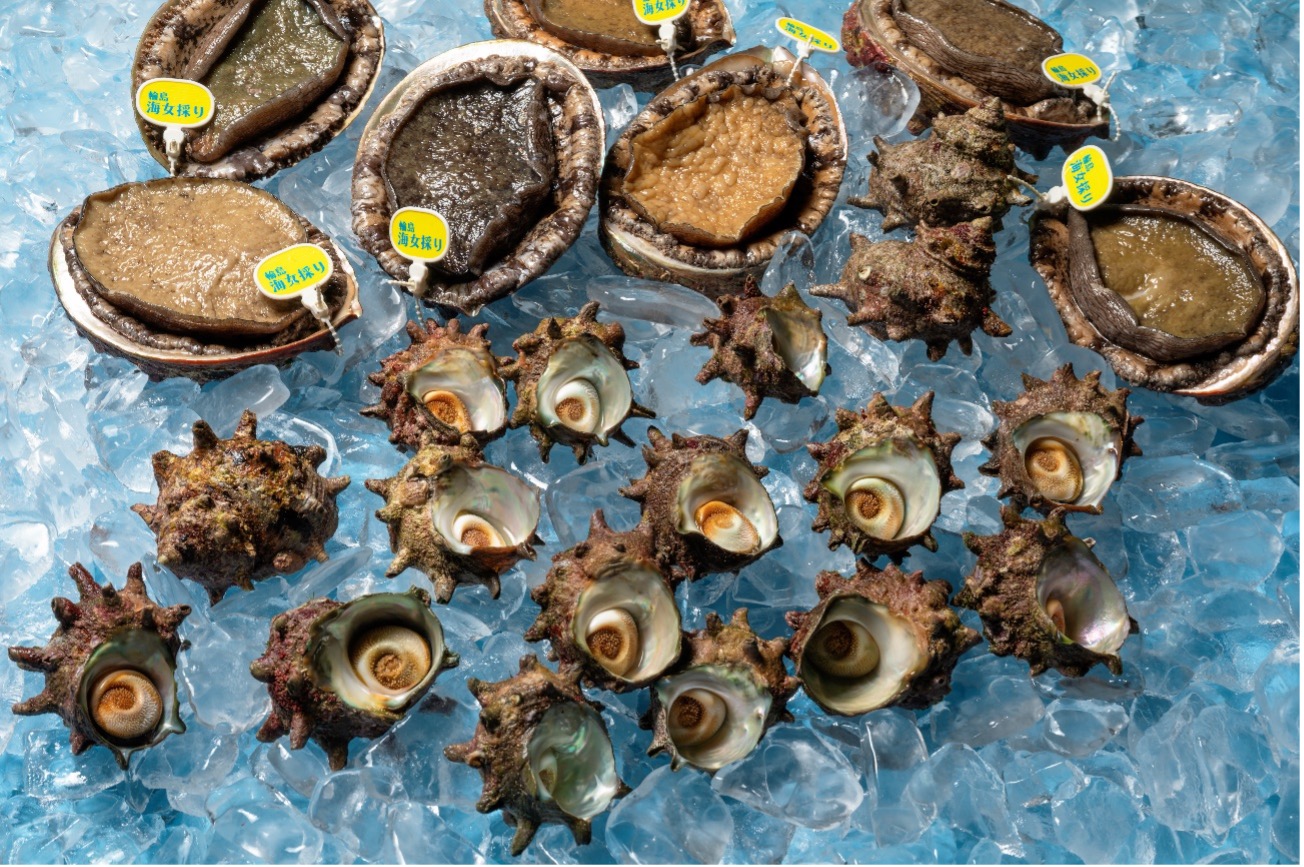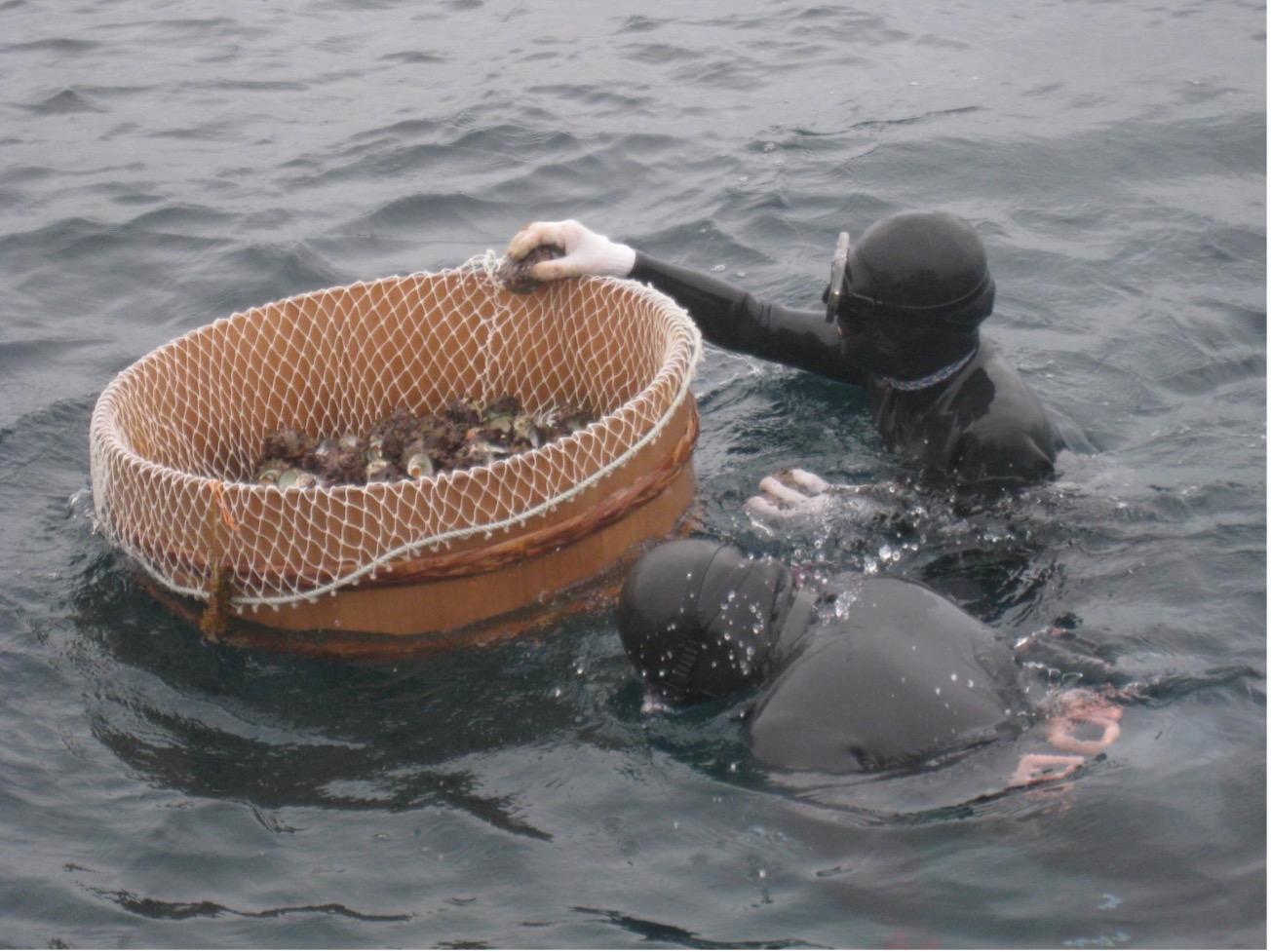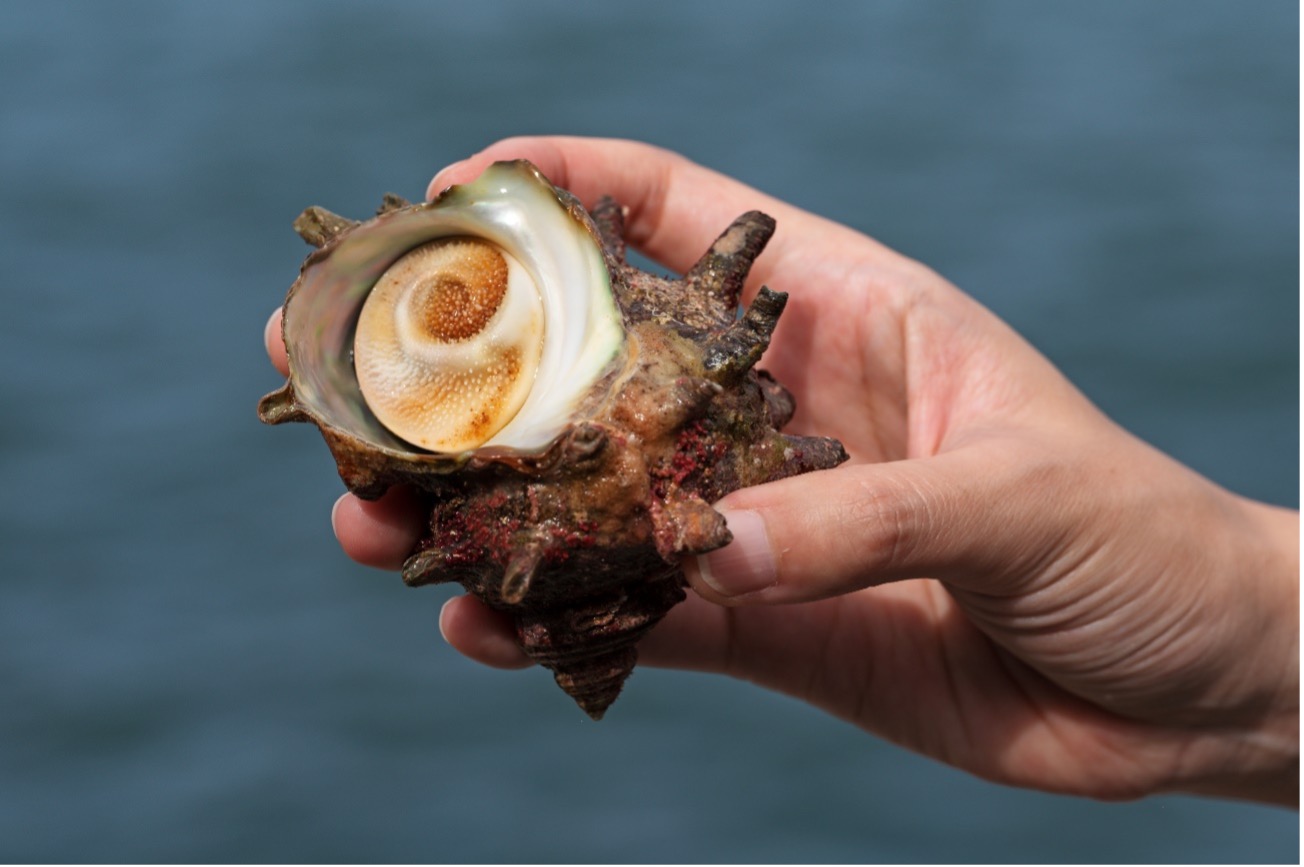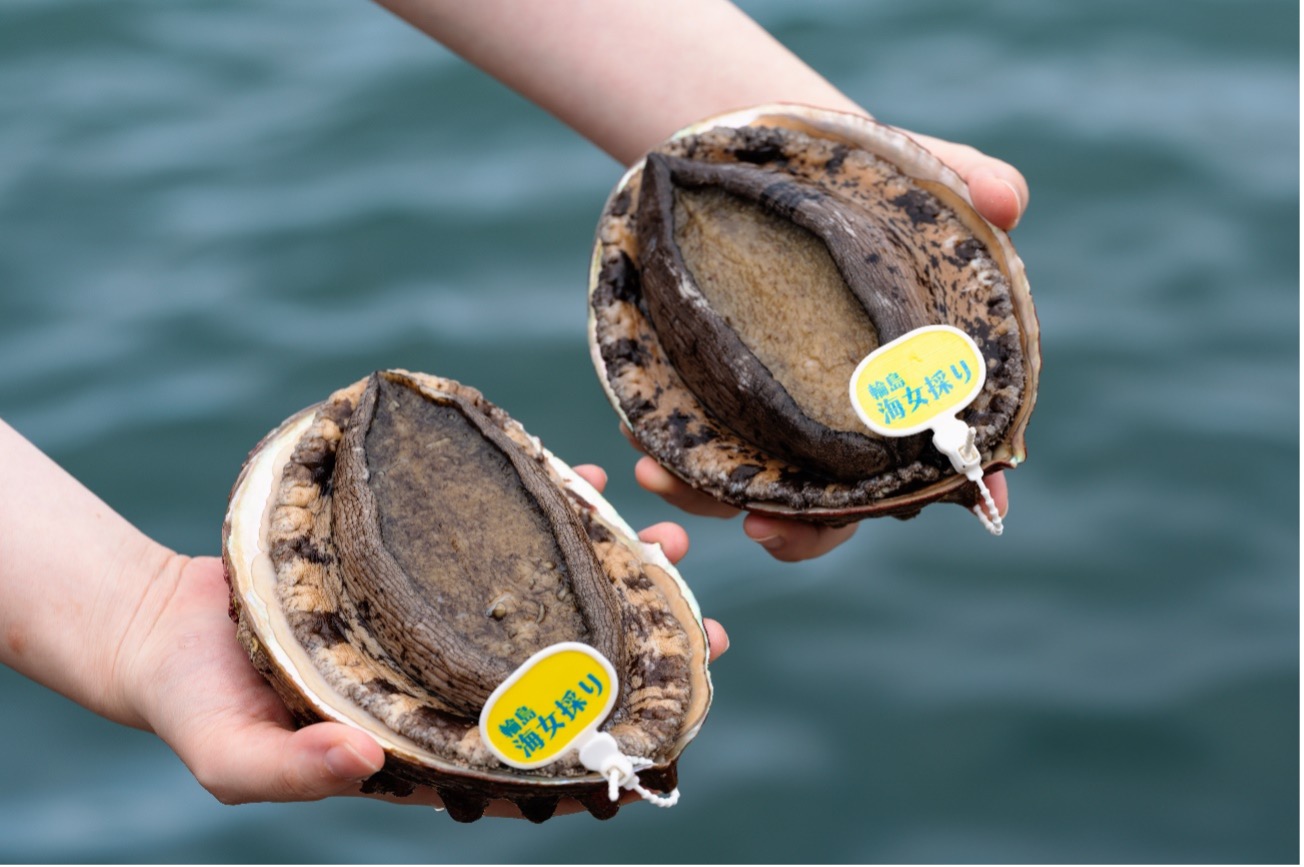Captivating with Their Briny Aroma and Pleasant Texture—Horned Turban Shells and Abalone Harvested by Wajima’s Ama Divers Through Traditional Freediving.

The Historic Tradition of Freediving Fishing, Passed Down by the Women of Wajima.
May this year’s harvest be bountiful as well—this is the hope the ama divers of Wajima hold in their hearts as they welcome the opening day of the freediving season for horned turban shells and abalones on July 1st each year.
Ama diving in Wajima City, located in the northern part of Ishikawa Prefecture, is said to have a history of at least 400 years and is even mentioned in the Manyōshū (an ancient anthology of Japanese poetry). Currently, there are about 200 active ama divers in Wajima, ranging in age from their 20s to 80s. This number ranks second in the country, after Mie Prefecture (according to the 2015 National Ama Culture Preservation and Promotion Conference survey). Many of these divers come from families where grandmothers or mothers worked as ama divers, and especially in the towns of Amamachi and Wajimazakimachi, many women live in harmony with the sea.
“From a young age, I would dive into the sea and collect small shellfish, such as shitadami (small spiral shells) and sazae (horned turban shells), to earn pocket money. Eventually, my parents and grandmother began taking me with them when they went fishing. They never formally taught me the techniques. It was more like, ‘Watch and learn,’” says Natsuki Kadoki, president of the “Wajima Ama Diving Preservation and Promotion Association,” who has been an ama diver for 26 years. “At first, I couldn’t dive well, so I practiced a lot,” says Miharu Hashimoto, who has been an ama diver for 15 years. Satomi Hashimoto, who also has 15 years of experience, became an ama diver after marrying into a family of ama divers. “My mother-in-law and aunt were both ama divers. Soon after I got married, they told me to try getting on the boat. If I didn’t like it, I could just get off.”
Thus, Wajima’s ama diving tradition has been passed down through generations, nurtured throughout history.
With Their Advanced Skills, Recognized as an Important Intangible Cultural Heritage of Japan.
To become an ama diver, one must be a woman living in the Amamachi and Wajimazakimachi areas of Wajima City, as well as a member of the Ishikawa Prefecture Fisheries Cooperative to exercise fishing rights for harvesting horned turban shells, abalone, and other shellfish. Additionally, the prefecture has introduced support measures to promote the inclusion of new ama divers to ensure the continuity of the tradition. These measures include subsidies for initial expenses, such as wetsuits, for new ama divers.
The fishing grounds are mainly around Hegura Island and Nanatsujima islands off the coast of Wajima. While some ama divers also dive to collect seaweed in the spring and winter, the peak season for horned turban shell and abalone fishing is during the open season from July to September. During this period, ama divers head out to sea by boat and, dressed in wetsuits, dive daily to depths of about 10 to 20 meters to harvest horned turban shells and abalone.
Wajima’s ama diving is highly regarded for several reasons: it boasts the largest number of active divers in the country for a single district, its origins trace back to the 16th century in Kyushu, and its history and traditions, including ancient fishing tools and customs, continue to be preserved and passed down by a cooperative organization called “Atari.” Furthermore, ama divers have actively managed and protected resources such as abalone and horned turban clams by voluntarily limiting fishing seasons and departure times. These efforts led to Wajima's ama diving being designated as an Important Intangible Cultural Heritage of Japan in 2018.

Hand-Harvested with Care and Delivered Fresh to the Harbor in a Seawater Tank.
Wajima’s horned turban shells and abalone are representative of summer flavors. The horned turban shell is characterized by its sharp, pointed horn, a sign that it was grown in the fast-moving currents of the sea. Those harvested by ama divers are free of sand and can be enjoyed down to the liver.
While some regions use nets to catch horned turban shells, in Wajima, ama divers harvest them individually by hand, minimizing damage to the shells.

Abalone inhabit deeper waters compared to horned turban shells. When they sense danger, they instinctively cling tightly to rocks. Ama divers use a specialized tool known as the “Obigane” to carefully detach them from the rocks and collect them. “We look for thick, raised abalones and quickly assess the type of rock they’re attached to, how they’re positioned, and the angle at which to insert the Obigane to avoid causing any damage,” says Misaki Yamagishi, an ama diver with 28 years of experience.

Experience the Freshness with Sashimi! Enjoy Local, Unique Ways to Eat It.
Horned turban shells are rich in protein, phosphorus, potassium, and zinc, and are believed to help maintain normal taste perception. The taurine they contain in abundance is also said to be effective in preventing aging. While eating them as sashimi or grilled in the shell is common, in Wajima, there is a unique way of eating them passed down through generations in each household, called “sazaebushi,” as explained by Mie Hamatani, an ama diver with 26 years of experience. “The flesh, which is taken out after cracking the shell, is soaked in plenty of salt for about six months. It is then cut into thin slices and eaten with rice. It has a distinct smell, so people’s preferences vary, but it’s delicious,” she said.
Known for its nutritional value, abalone is high in protein, low in calories, and rich in minerals such as zinc, iron, magnesium, and B vitamins. In addition to being enjoyed as sashimi with liver served in a vinegary soy sauce dressing, it can also be savored in dishes like butter sauté or rice cooked with abalone.
Striving for Stable Catch Volumes Through Resource Conservation—
The decline in the catch volumes of both horned turban shells and abalone compared to the past is a source of concern for ama divers. The catch of horned turban shells decreased from 201 tons in 2009 to 68 tons in 2018, but it recovered to 112 tons in 2022. However, the situation with abalone is more serious, as the catch has continued to decline from 4.5 tons in 2009 to just 1.4 tons in 2022.
One of the reasons for this decline is the change in the marine environment. “The changes in the sea are striking. Seaweed that we’ve never seen before is starting to grow, and the kelp that feeds horned turban shells and abalone is becoming scarce,” says Ms. Kadoki. “The water temperature has risen, and even the fish swimming in the water are changing,” says Ms. Hamatani, her expression clouded with concern.
In response to this situation, ama divers are also engaged in resource conservation efforts, such as releasing juvenile shellfish into the sea.
Currently, freediving for abalone and horned turban shells is restricted to July 1–September 30 for resource protection. Even during this period, fishing hours have been shortened from 2:00 p.m. to 1:00 p.m. Additionally, abalone under 10 cm and horned turban shells below a strictly defined size classification are not harvested.
Divers also refrain from collecting ego seaweed, which serves as a spawning ground for horned turban shells. To improve the shellfish habitat, they remove sea urchins that compete for food, eradicate octopuses that prey on abalone, and clean the seafloor.
The Perilous Work of Ama Diving: Appreciating the Ocean’s Bounty
Ama diving, which depends on nature, has its risks. Ms. Kadoki recalls being stung by a stonefish. “Stonefish have venomous fins, but they blend in with the rocks, making them hard to spot.” She and her fellow divers are also on the lookout for sharks and stingrays, which have venomous tails.
Despite the challenges, the joy of a good catch makes it all worthwhile. And so, once again, Ms. Kadoki and her fellow divers plunge into the sea.
The horned turban shells and abalone from Wajima, carefully harvested by the ama divers despite the risks, offer a delightful taste. With their pleasantly firm texture and subtle bitterness, the flavors seem to carry not only the gentle landscape of Wajima’s waters and the scent of the sea, but also the ama divers’ deep gratitude to the ocean.
Reference: Noto Satoyama’s Treasure—The Techniques of Ama Diving in Wajima (Wajima City)